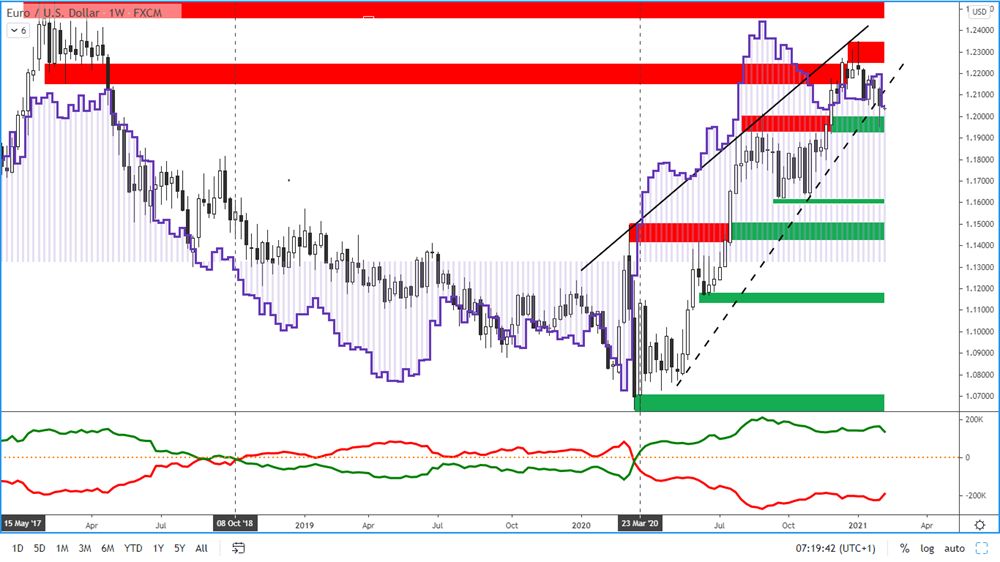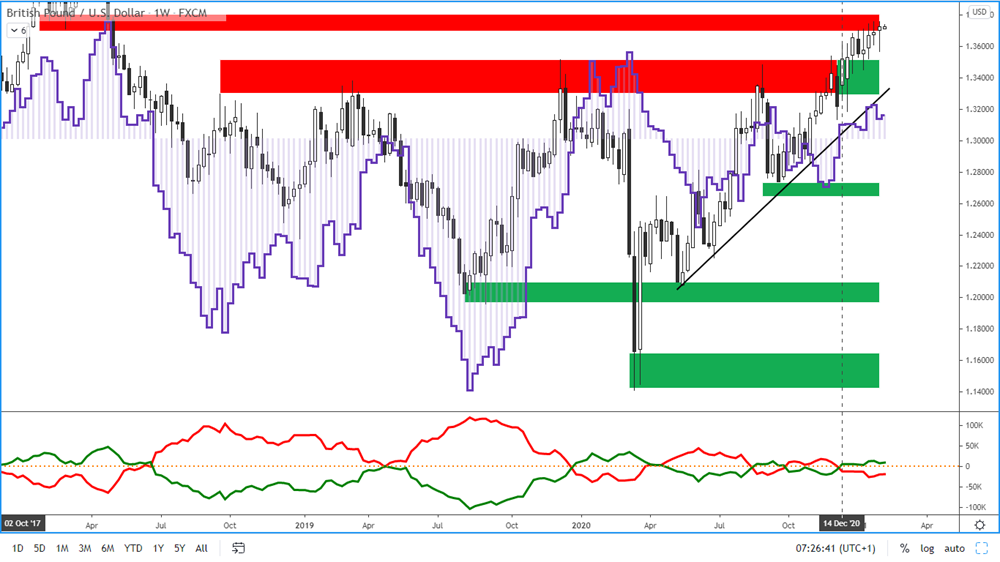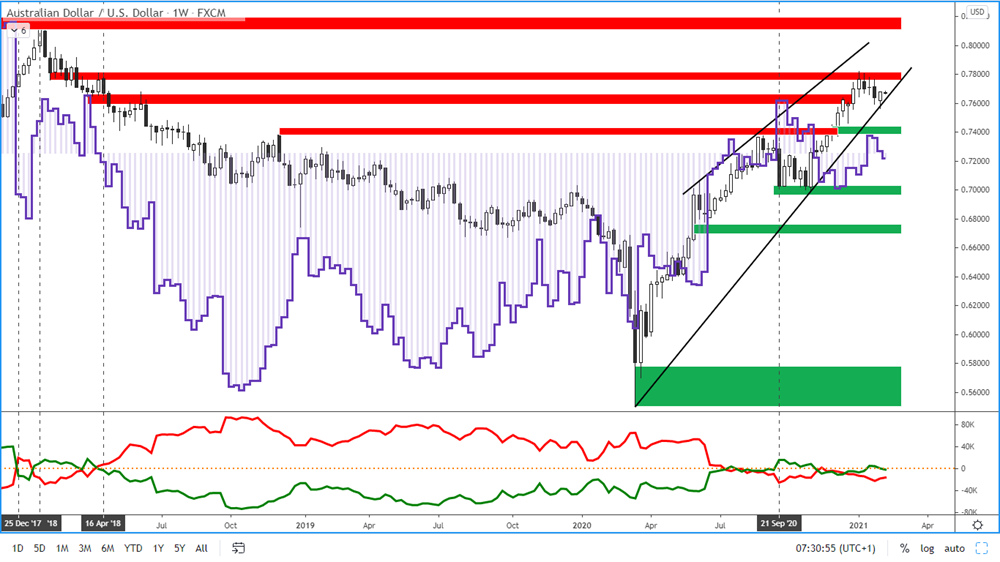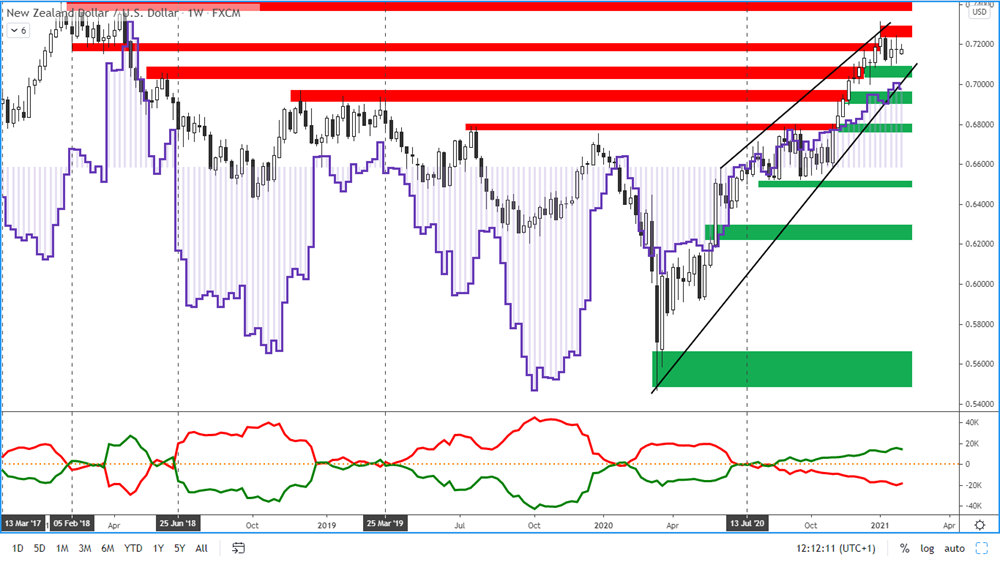Positions of large speculators according to the COT report as at 5/2/2021
Total net positions in the USD index fell by 100 contracts last week. This change is the result of an increase in net long positions by 600 and an increase in net short positions by 700 contracts. The overall net positions in the USD index have been negative for thirteen weeks in a row. At the end of last week, the US dollar weakened significantly due to weaker NFP data.
There was a sharp decline in total net positions in the euro, probably due to worse economic development in Europe. There was also a decline in total net positions in the Australian dollar, the New Zealand dollar and the Japanese yen.
Total net positions rose last week in the British pound, the Canadian dollar and the Swiss franc.
Risk on sentiment persists in the markets and the SP500 stock index reached a new high last week. This could be favorable for commodity currencies, which might strengthen.
The positions of speculators in individual currencies
|
|
5/2/2021
|
29/1/2021
|
22/1/2021
|
15/1/2021
|
8/1/2020
|
4/1/2021
|
|
USD index
|
-14,800
|
-14,700
|
-14,300
|
-13,900
|
-15,000
|
-14,600
|
|
EUR
|
137,000
|
165,300
|
163,500
|
155,900
|
143,000
|
143,100
|
|
GBP
|
9,700
|
8,000
|
13,700
|
12,900
|
3,700
|
4,800
|
|
AUD
|
-1,500
|
800
|
4,900
|
5,500
|
- 3,900
|
-6,500
|
|
NZD
|
11,600
|
14,800
|
16,000
|
14,700
|
12,000
|
12,500
|
|
CAD
|
16,100
|
13,800
|
10,300
|
12,100
|
14,500
|
15,400
|
|
CHF
|
14,600
|
10,100
|
9,400
|
12,000
|
9,400
|
11,800
|
|
JPY
|
44,600
|
45,000
|
50,000
|
50,500
|
50,200
|
47,300
|
Table 1: Total net positions of large speculators
Notes:
Large speculators are traders who trade large volumes of futures contracts, which, if the required limits are met, must be reported to the Commodity Futures Trading Commission. Typically, this includes traders such as funds or large banks. These traders mostly focus on trading of long-term trends.
Total net positions are the difference between the number of bullish long contracts and the number of bearish short contracts. The data is published every Friday and is delayed because it shows the status on Tuesday of the week.
The sentiment of large speculators will allow you to see what position this group occupies in the market. It is important to monitor the overall trend of total net positions, but also separately the trend of bearish short positions and the trend of bullish long positions. Extreme values of total net positions are also important as they often serve as signals of a trend reversal.
It is also important to monitor the turning points, when the total net positions change from bullish sentiment to bearish and vice versa. These inflection points are indicated in the graphs in section 3.
The chart compares the current value of the total net positions of large speculators with the value 3 years ago. A score of 0% means that speculators are at their lowest levels in 3 years. A score of 100% means that speculators are at the highest values in the last 3 years. A value of 80% or more means that speculators are extremely bullish, and a value of 20% or less means that speculators are extremely bearish.
Detailed analysis of selected currencies
Explanations:
-
Purple line and histogram in the chart window: this is information on the overall net position of large speculators.
-
Green linein the indicator window: these are the bullish positions of large speculators.
-
Red line in the indicator window: indicates the bearish positions of large speculators.
If there is a green line above the red line in the indicator window, then it means that the overall net positions are positive, i.e. that bullish sentiment prevails. If, on the other hand, the green line is below the red line, then bearish sentiment prevails and the overall net positions of the big speculators are negative.
Charts are made with the use of www.tradingview.com.
Euro
|
Weekly change in total net positions
|
Weekly change in total long positions
|
Weekly change in total short positions
|
Sentiment
|
|
- 28,300
|
-21,200
|
7,100
|
bullish
|

Figure1: The euro and COT positions of large speculators on a weekly chart
Total net positions fell by 28,300 contracts last week. This is a very strong change, which is caused by a decrease in net long positions by 21,200 contracts and an increase in net short positions by 7,100 contracts. The big players significantly reduced their long positions, probably due to the spread of the coronavirus pandemic in Europe and a worse economic situation in the region.
The price of the euro weakened significantly last week and passed support on a growing trend line. But on Friday the price returned above this level so it could be a fake break. The price reached horizontal support in the band around 1.20, which has been respected so far.
Long-term resistance: 1.2250 - 1.2340
Long-term support: 1.1940 - 1.2000
The British Pound
|
Weekly change in total net positions
|
Weekly change in total long positions
|
Weekly change in total short positions
|
Sentiment
|
|
1,700
|
6,300
|
4,600
|
bullish
|

Figure 2: The GBP and COT positions of large speculators on a weekly chart
Last week, total net positions rose by 1,700 contracts. This change is the result of an increase in net long positions by 6,300 contracts, while net short positions grew by 4,600 contracts.
The pound strengthened slightly last week, especially after interest rates were left unchanged and the governor said that economic recovery and inflation could rise faster than expected. The pound continues to move in the area of resistance.
Long-term resistance: 1.37-1.3820
Long-term support: 1.33-1.3500
The Australlian Dollar
|
Weekly change in total net positions
|
Weekly change in total long positions
|
Weekly change in total short positions
|
Sentiment
|
|
- 2,300
|
- 600
|
1,700
|
bearish
|

Figure 3: The AUD and COT positions of large speculators on a weekly chart
Last week, total net positions fell by 2,300 contracts and returned to negative bearish sentiment. This change is the result of a decrease in net long positions by 600 contracts, while net short positions increased by 1,700 contracts.
The Australian dollar strengthened slightly last week due to the risk on sentiment on the SP 500 stock index, which the Australian dollar correlates with. As the SP 500 has reached a new high, it is possible that AUDUSD will follow this growth. The current support can be understood as the lower growing trend line.
Long-term resistance: 0.7750-0.7820
Long-term support: 0.7600-0.7650
The New Zealand Dollar
|
Weekly change in total net positions
|
Weekly change in total long positions
|
Weekly change in total short positions
|
Sentiment
|
|
- 3,200
|
2,300
|
5,400
|
bullish
|

Figure 4: The NZD and the position of large speculators on a weekly chart
In the New Zealand dollar, total net positions are still in bullish sentiment, which has been going on for 25 consecutive weeks. Last week, however, total net positions fell by 3,200 contracts. This change is the result of an increase in net long contracts by 2,300 contracts and a decrease in net short contracts by 5,400.
The price of the NZDUSD strengthened slightly last week. As with the Australian dollar, a strengthening in the NZDUSD is possible due to risk on sentiment as a new high on the SP 500 was reached.
Resistance: 0.7230-0.7320
The nearest support: 0.7050-0.7100